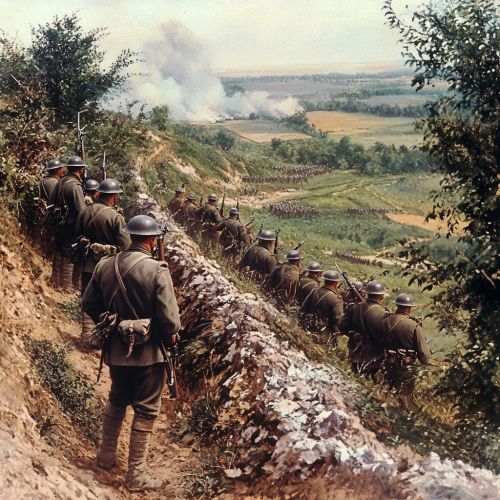First Battle of the Marne
First Battle of the Marne
The First Battle of the Marne, fought from 6 to 12 September 1914, was a significant engagement during the early stages of World War I. It marked the end of the German advance into France and the beginning of the trench warfare that would characterize much of the conflict. The battle involved the French Army, the British Expeditionary Force (BEF), and the German Army.


Background
The First Battle of the Marne occurred after the German Army's rapid advance through Belgium and northern France, following the Schlieffen Plan. This plan aimed to quickly defeat France by encircling Paris and then turning east to confront Russia. The German forces, under the command of General Helmuth von Moltke the Younger, had achieved significant early successes, pushing the Allied forces back towards the Marne River.
Prelude
By early September 1914, the German First and Second Armies, commanded by Generals Alexander von Kluck and Karl von Bülow respectively, had reached the Marne River, just 30 miles from Paris. The French and British forces, under the overall command of General Joseph Joffre, were in retreat but managed to regroup and prepare for a counteroffensive. The French Sixth Army, led by General Michel-Joseph Maunoury, played a crucial role in the upcoming battle.
The Battle
The battle began on 6 September 1914, when the French Sixth Army launched an attack on the right flank of the German First Army. This move forced von Kluck to divert his forces to meet the threat, creating a gap between the German First and Second Armies. Recognizing the opportunity, General Joffre ordered a general counteroffensive along the entire front.
The BEF, under the command of Field Marshal Sir John French, advanced into the gap between the German armies, further widening it and threatening the German lines of communication. The French Fifth Army, commanded by General Louis Franchet d'Espèrey, also attacked the German Second Army, adding to the pressure on the German forces.
Turning Point
The critical moment of the battle came on 9 September when the French Ninth Army, led by General Ferdinand Foch, launched a determined assault on the German Second Army. Despite initial setbacks, Foch's forces managed to hold their ground and even counterattacked, famously stating, "My center is giving way, my right is retreating, situation excellent, I am attacking."
The combined pressure from the French and British forces forced the German armies to retreat. By 12 September, the German High Command ordered a general withdrawal to the Aisne River, where they began to dig in and establish defensive positions. This marked the end of the German advance and the beginning of the static trench warfare that would dominate the Western Front for the next four years.
Aftermath
The First Battle of the Marne was a decisive Allied victory that halted the German advance and saved Paris from capture. The battle resulted in significant casualties on both sides, with estimates of around 250,000 for the Allies and a similar number for the Germans. The failure of the Schlieffen Plan forced Germany to fight a prolonged two-front war, which ultimately contributed to their defeat in 1918.
The battle also had significant strategic implications, as it demonstrated the importance of rapid communication and coordination among Allied forces. The use of reconnaissance aircraft and radio communication played a crucial role in the success of the Allied counteroffensive.
Legacy
The First Battle of the Marne is remembered as one of the most important battles of World War I. It marked the end of mobile warfare on the Western Front and the beginning of trench warfare, which would lead to a prolonged and grueling conflict. The battle also highlighted the resilience and determination of the Allied forces, who managed to regroup and launch a successful counteroffensive despite being in retreat.
The Marne River, where the battle took place, has since become a symbol of French resistance and determination. The battle is commemorated in various memorials and monuments throughout the region, honoring the soldiers who fought and died in this pivotal engagement.
